The Cold War: A MILITARY History (73 page)

APPENDIX
25
Main Battle Tanks: NATO and Warsaw Pact
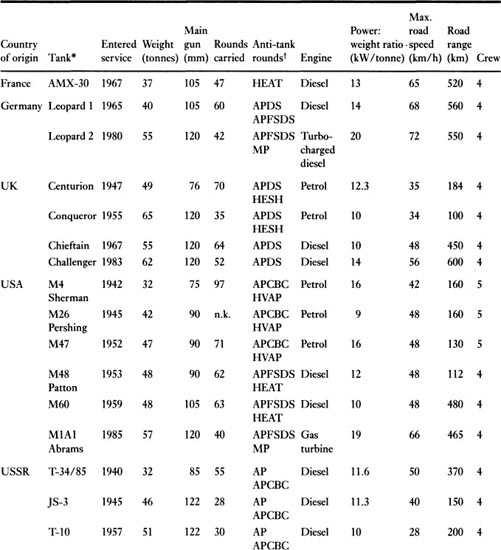
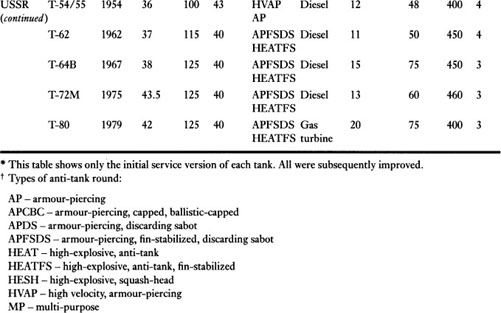
APPENDIX
26
Artillery: NATO and Warsaw Pact
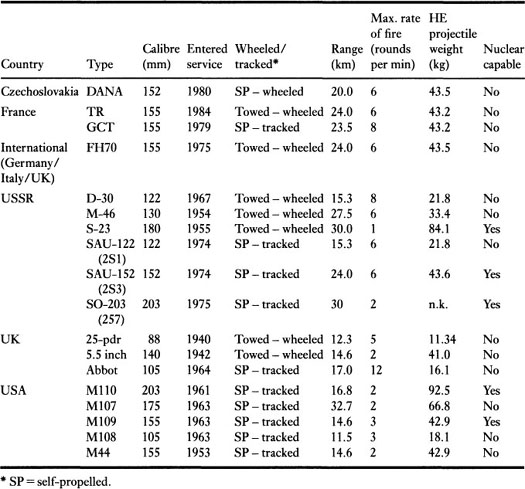
APPENDIX
27
Tactical Nuclear Weapons Systems
USA
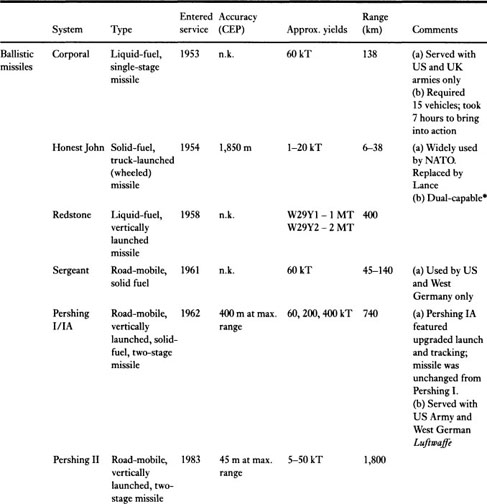
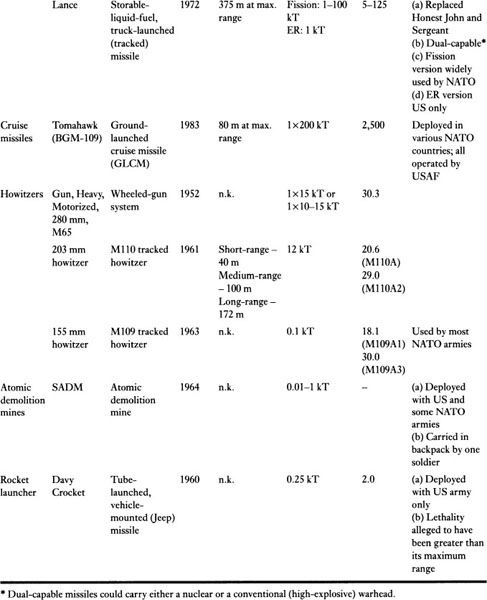
USSR
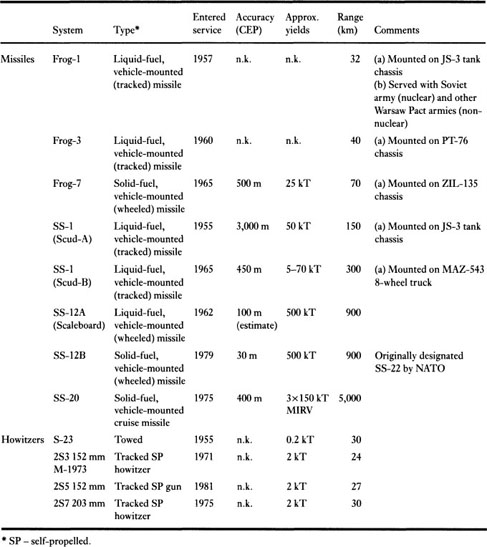
APPENDIX
28
A Hypothetical US Counter-Force Attack on Soviet Strategic Forces in 1986
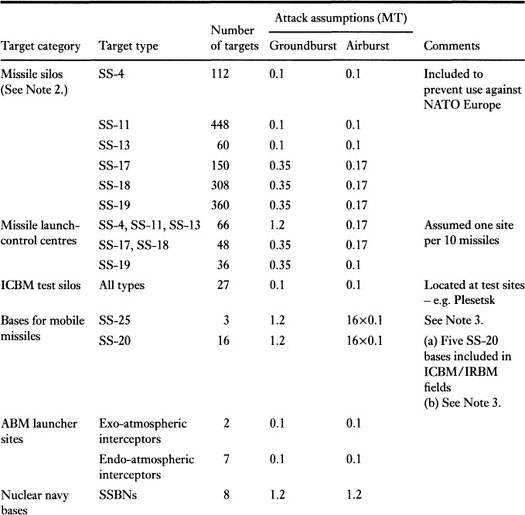
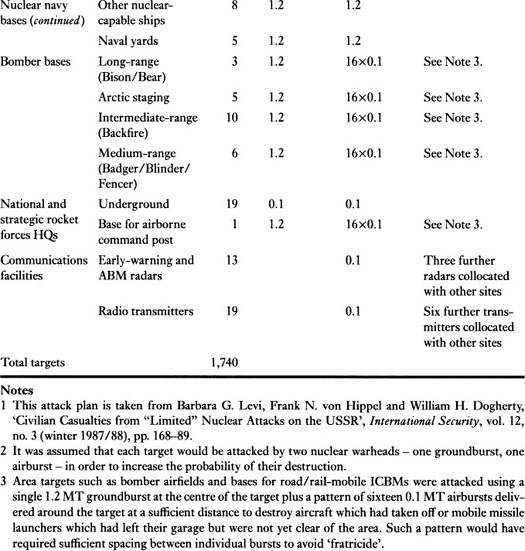
Glossary
Note
Italic type indicates that there is a glossary entry for the word italicized.
ABM
Anti-ballistic missile – a missile capable of destroying incoming
ballistic missiles
or their warheads before they impact on their target.
ABM
Treaty The ABM Treaty, signed on 3 October 1972, limited both the USA and the USSR to two
ABM
sites. One allowable site was the national capital; the other was at an
ICBM
field. Not more than 100 launchers and 100 missiles were allowed at each site.
ACE
Allied Command Europe (NATO).
AFCENT
Allied Forces Central Europe (NATO).
ALCM
Air-launched
cruise missile
.
APC
Armoured personnel carrier. A tracked or wheeled vehicle designed to carry
infantry
men.
Army formations and units
Armies used the same terms to describe their constituent elements, but with widely differing meanings. In general, the following meanings apply.
BATTALION
The smallest permanent tactical unit, made up of a number of companies, each consisting of a number of platoons. A battalion was commanded by a lieutenant-colonel in some armies and by a major in others. Battalions varied in size from about 500 to 1,000 men. There were various types of battalion, their role normally being indicated in their title – e.g. 234 Motor Rifle Battalion, 2 Armoured Battalion, 24 Infantry Battalion, etc. Most British battalions had names – e.g. 1st Battalion, Green Howards – and did not have an indicator of their role.
REGIMENT
‘Regiment’ had four rather different meanings:
• In some armies a regiment was a permanent tactical formation consisting of two to four battalions, but without integral supporting arms such as armour and artillery.
• In the Soviet army a regiment was a permanent tactical unit, consisting of a number of battalions with integral all-arms support. There were three
motor-rifle
regiments and one tank regiment in a motor-rifle division. The Soviet regiment was thus equivalent in most respects to a NATO brigade.
• In some armies a regiment was an administrative and historical entity, composed of a number of battalions, each of which operated as a totally independent tactical unit. For example, the Queen’s Regiment in the UK consisted of a number of battalions which operated independently of each other – thus, 1/QUEENS, 2/QUEENS, etc.
• Some armies designated battalion-sized units with a cavalry history as a regiment. Thus, in the British army units designated as tank, artillery and engineer regiments were, in fact, the same size as battalions.
BRIGADE
A brigade was composed of a number of battalions – usually three tank battalions and one infantry battalion (armoured brigade) or one tank battalion and three infantry battalions (infantry brigade):
• In most armies a brigade was an all-arms force, which included integral artillery, engineer, aviation, communications and logistics units.
• In some armies brigades could be reinforced, when they were usually known as ‘brigade groups’.
• The brigade commander was usually a brigadier-general, a brigadier (British army) or a colonel.
DIVISION
Both NATO and the Warsaw Pact had divisions, composed of between two and five brigades (regiments in the Soviet army). These were designated as either ‘tank’ or ‘infantry’, depending upon which arm predominated. In most armies a division was commanded by a major-general, or equivalent. It is important to note that there were wide variations in numerical strength and capability between the divisions of different nations.
CORPS
(
NATO
) A corps was the highest national formation and was made up of a number of divisions, plus a large number of corps troops (additional artillery, engineers, signals, logistics troops, etc.). Corps were not, however, designated ‘tank’ or ‘infantry’, but the national designator was always used (e.g. 3 (US) Corps). A corps was commanded by a general or lieutenant-general.
ARMY
(
WARSAW PACT
) In the Warsaw Pact an army was approximately equivalent in size to a NATO corps and included its predominant arm in its title – e.g. ‘Tank Army’ or ‘Combined-Arms Army’.
ARMY GROUP
(
NATO
) Originally used to designate a collection of armies (e.g. 21st Army Group), but in NATO the term was used to describe a collection of corps (e.g. CENTAG = Central Army Group). A NATO army group was commanded by a general.
Assured destruction
Strategic term, describing the ability to inflict unacceptable damage on an enemy.
ASW
Anti-submarine warfare.
AWACS
Airborne warning and control system – an aircraft-mounted radar system designed to detect and track enemy aircraft and land vehicles, and to direct action against them.
Ballistic missile
A projectile, propelled into space by a rocket motor, which then follows a ballistic trajectory – i.e. one governed mainly by gravity and drag.
Battalion
See
Army formations and units
.
Bias
The distance between the aiming point for one or more warheads directed at the same target and the mean point of impact.
Booster
A self-contained rocket motor attached to a missile to give extra thrust for take-off, after which it was usually jettisoned.
Brigade
See
Army formations and units
.
Brigade group
See
Army formations and units
.
Bundeswehr
The armed forces of the Federal Republic of Germany, comprising the
Bundesmarine
(navy),
Bundesheer
(army) and
Luftwaffe
(air force).
Bus
See
Post-boost vehicle
.
C
3
Command, control and communications – equipment, personnel and procedures used to acquire, process and disseminate data needed by decision-makers to plan and control operations.
CENTAG
Central Army Group (NATO).
CEP
Circular error probable – a term used to describe the delivery precision of a weapon, particularly a missile
warhead
. The CEP is the radius of a circle, centred upon the mean point of impact, within which 50 per cent of the warheads aimed at the target will fall. The CEP is normally assessed at the missile’s maximum range; at less than maximum range the CEP reduces in proportion.
Civil defence (CD)
Passive measures taken to minimize the effects of enemy action upon all aspects of civil life, and to restore utilities and facilities following an attack.
CIWS
Close-in weapons system – naval gun systems designed to give last-ditch defence against incoming aircraft and missiles.
CMP
Counter-military potential – a static measure of the ability of nuclear weapons to damage hard targets such as missile silos.
Cold launch
A method of expelling a missile from a launch tube using compressed air. The missile main motor fires once the missile is clear of the tube, which is therefore not damaged and can be reused. See also
Hot launch
.
Conventional power
A propulsion or generating system which does not use nuclear power. Usually applied to ships and submarines.
Conventional war
A war in which nuclear weapons are not used.
Conventional warhead
A non-nuclear
warhead
, normally high-explosive.
Corps See
Army formations and units
.
Counter-force
Describes strategic attacks using nuclear weapons directed against enemy weapons and military forces, especially nuclear-weapon delivery systems.
Counter-value
Describes the use of strategic forces to attack selected enemy population centres, industries and other resources which constitute the essential fabric of the nation.
CPSU
Communist Party of the Soviet Union.
Cruise missile
A missile which flies for long distances supported by lift from the wings and/or body. Power is provided by an air-breathing engine, such as a turbojet. Cruise missiles could be launched from aircraft (ALCM = air-launched cruise missile), the ground (GLCM), ships or submarines (SLCM).
Deterrence
A political and military strategy designed to prevent potential enemies from taking armed action, or, if conflict should break out, to prevent it from escalating.
Displacement
The displacement of a warship is the mass of water displaced by a ship’s hull when floating. In this book the displacement given for surface warships is the ‘standard’ figure – i.e. when the ship is fully manned and stored, but without fuel or reserve feed-water for boilers. The figure is expressed in tonnes, using published figures for navies using the metric system and imperial tons or US short tons converted to metric tonnes in the case of British and US warships. For submarines the displacement is given for the submarine when submerged.
Division
See
Army formations and units
.
Dual capable
Able to carry either nuclear or conventional bombs/missiles (aircraft) or
warheads
(missiles/guns).
ECCM
Electronic counter-countermeasures – a form of electronic warfare designed to overcome enemy use of
ECM
and thus permit continued use of the electromagnetic spectrum.
ECM
Electronic countermeasures – a form of electronic warfare designed totally or partially to prevent effective use by the enemy of the electromagnetic spectrum.
ELINT
Electronic intelligence – intelligence derived from enemy electronic emissions other than telecommunications (e.g. radar). See also
SIGINT
.
EMP
Electromagnetic pulse – a sharp pulse of radio-frequency electromagnetic radiation produced by a nuclear explosion.
EMT
Equivalent megatonnage – a measure of damage by nuclear weapons against ‘soft targets’ such as cities.
Enhanced radiation (ER)
– describes a nuclear weapon designed to release about 80 per cent of its
yield
in high-energy neutrons, resulting in a weapon more dangerous to people than to military equipment or structures. Also known as the ‘neutron bomb’.
ER
See
Enhanced radiation
.
First strike
The first offensive move in a conflict. As applied to nuclear warfare, it implies an attempt to eliminate effective retaliation by the enemy.
Flexible response
A strategy based on the capability to act effectively across the entire spectrum of war, at the time, place and manner of the user’s choosing.
FOBS
Fractional Orbital Bombardment System – a nuclear warhead delivered by a partial orbit, enabling the approach to be made from any direction.
Fratricide
The situation when more than two nuclear warheads arrive nearly simultaneously at the same target, and the first warhead to explode therefore either destroys or diverts the following warhead(s).
FRG
Federal Republic of Germany – during the period covered by this book, West Germany (Bundesrepublik Deutschland).
Front end
The forward part of a missile, containing the
post-boost vehicle, warheads, penetration aids
, etc.
GDR
German Democratic Republic – East Germany (Deutsche Demokratik Republik).
General war
Armed conflict involving the two superpowers.
GLCM
Ground-launched
cruise missile
.
GSFG
Group of Soviet Forces Germany.
GZ
Ground zero – the point on the earth’s surface upon, above or below which a nuclear explosion takes place. All effects of the explosion are expressed at distances from GZ.
Hardened
Protected against the effects of nuclear weapons. This term was usually applied to ‘hardened aircraft shelters’ (HAS), ‘hardened equipment shelters’ (HES), pilot briefing facilities (PBF), etc.
Hardness
The ability of a target to withstand a nuclear explosion and its effects of shock, heat, radiation and
EMP
. Normally expressed in terms of overpressure withstood in kgf/cm
2
.
HE
High explosive.
Hot launch
A launch in which a missile is expelled from the launch tube using the missile’s main motor. See also
Cold launch
.
IBM
See
IRBM
.
ICBM
Intercontinental [range] ballistic missile – a land-based missile with a range in excess of 3,000 nautical miles (5,560 km).
ICV
Infantry combat vehicle – an armoured vehicle designed to carry between six and ten infantrymen, who were able to fire their weapons from within the vehicle. Sometimes also known as ‘mechanized-infantry combat vehicle’ (MICV).
INF
Intermediate-range nuclear forces – e.g.
IRBM
s.
Infantry
Infantry are troops who, traditionally, capture ground in the attack and hold ground in the defence. In the Cold War the designation ‘infantry’ was frequently qualified to indicate their method of transportation:
